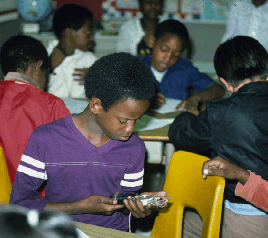Approach
Every elementary school teacher knows the sequence of
teaching arithmetic to elementary school students. Even non-teachers realize
that you donít teach calculus first! Counting, addition, subtraction,
multiplication, and division is your basic learning sequence. Sometimes the
methodology may vary, but the sequence does not.
 So,
when you ask an elementary teacher what the basic sequence of science is, they
look horrified! Some declare there is none, but the majority are clueless.
Science like math is logical, if flows from one point to another like a good
melody. Einstein eloquently revealed his secret, when asked why he is a
"genius." He humbly, but correctly replied, "I stand on the
shoulders of giants." All previous works had to have been studied in order
for him to have extended the limits of scientific inquiry.
So,
when you ask an elementary teacher what the basic sequence of science is, they
look horrified! Some declare there is none, but the majority are clueless.
Science like math is logical, if flows from one point to another like a good
melody. Einstein eloquently revealed his secret, when asked why he is a
"genius." He humbly, but correctly replied, "I stand on the
shoulders of giants." All previous works had to have been studied in order
for him to have extended the limits of scientific inquiry.
The content of science is rich, but within each field of
science you have basic building blocks. If the block of science content builds a
foundation, then science is easier to understand. Elementary teachers may have
only taken one or two classes in science and do not know how sciences weave a
web of logic.
The Life Cycle is unique on this planet. The
diversity of life is dependant on the Water Cycle. But where did all
the water come from? One of the rocks produced in the Rock Cycle (igneous)
produces the energy needed to combine hydrogen and oxygen to produce the
primordial water which slowly accumulated into oceans and lakes. The Plate
Tectonic Cycle creates the different environments for rocks to be
created. Volcanoes and earthquakes, are actually signs of a living
Earth. The Universe Cycle, in all its wonders, produced the Earth,
that created the water that sustains every living creature. This study of
all these sciences produces knowledge that allows scientists, engineers and
mathematicians to discover new technology, which gives us Applied Sciences. Science
is interrelated. In order to understand content in one subject, you
sometimes need to understand the content in another.
Teachers need to understand that sciences are
interrelated. Many elementary school teachers may only have had only one science
course during their entire college career. Try to help your teacher understand
that science is a wonderful series of questions that sometimes have no answers.
It is an exciting subject to teach because it can make children speculate about
their world. Unfortunately, teachers feel uncomfortable if they cannot answer a
question. Teach them it is "ok" not to know everything and that a
search for knowledge is as rewarding as knowing the answer.
The I. Science MaTe Curriculum tries to structure the
learning of children throughout their elementary experience in a district. The
goal is to expose children to the major disciplines of science before a child
leaves elementary school. Children prefer science more than any other subject if
it is taught in a hands-on approach that makes them understand phenomena that
they observe. This program tries to make children discover, describe, compare,
and interpret. The primary objective of the Integrating Science, Math and
Technology (I. Science MaTe) curriculum is to give elementary students a basic
foundation of science. The program is designed so that scientific concepts are
built upon by repeating them in more complexity each year. You should have a
copy of the scope and sequence which outlines 34 weeks of instruction based on
the Integrating Science, Math, and Technology curriculum.
Children learn key scientific concepts by repetition. We
do not expect students to memorize the content, but to experience scientific
phenomena through hands-on materials. Do not feel discouraged or frustrated if
the younger children do not absorb or even understand it all. The goal in the
early grades (K-2) is to expose the children to the concepts so that when they
are revisited in subsequent years, they will be familiar.
The curriculum is intended as a structured guide. The
lesson plans can be adapted to the learning style of your children. The picture
below shows the build up of content every year, so children have a full
understanding of key components by the end of primary education. This will built
up in secondary school in the I. Science MaTe secondary curriculum.

Applied
Science - Our Technological World
 So,
when you ask an elementary teacher what the basic sequence of science is, they
look horrified! Some declare there is none, but the majority are clueless.
Science like math is logical, if flows from one point to another like a good
melody. Einstein eloquently revealed his secret, when asked why he is a
"genius." He humbly, but correctly replied, "I stand on the
shoulders of giants." All previous works had to have been studied in order
for him to have extended the limits of scientific inquiry.
So,
when you ask an elementary teacher what the basic sequence of science is, they
look horrified! Some declare there is none, but the majority are clueless.
Science like math is logical, if flows from one point to another like a good
melody. Einstein eloquently revealed his secret, when asked why he is a
"genius." He humbly, but correctly replied, "I stand on the
shoulders of giants." All previous works had to have been studied in order
for him to have extended the limits of scientific inquiry.